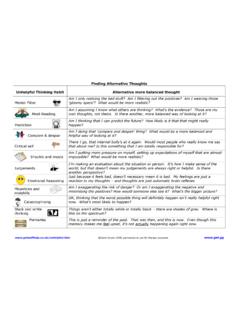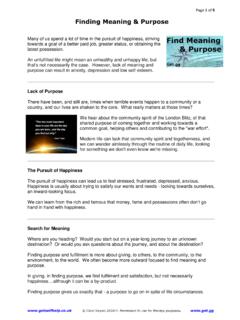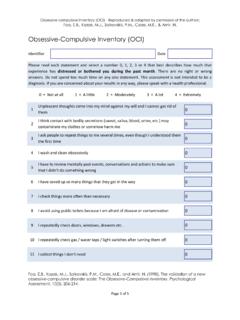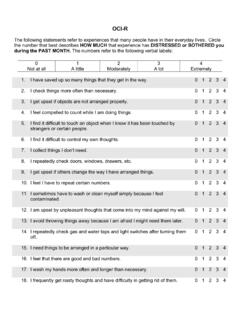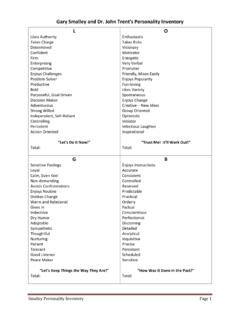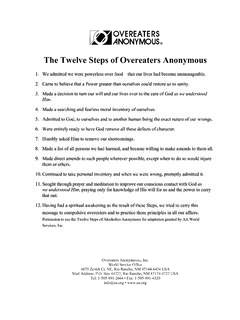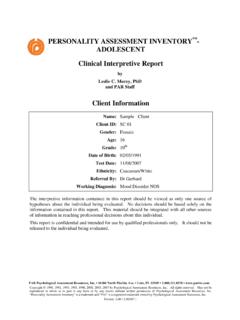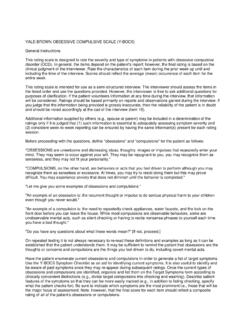Transcription of OCD Obsessive Compulsive Disorder - GET
1 Page 1 of 5 Carol Vivyan 2015. Permission to use for therapy purposes. OCD Obsessive Compulsive Disorder Obsessive Compulsive Disorder (OCD) is an anxiety Disorder dominated by obsessions (intrusive thoughts, images) and compulsions (rituals, urges and behavioural responses to the thoughts). A lot of people with OCD feel very responsible for preventing a terrible thing from happening ( I must keep bacteria away from my family otherwise they might become ill or die and it will be my fault"). Others do not have these catastrophic thoughts, but might feel very uncomfortable and become increasingly anxious and distressed if they don't do what their head is telling them to do. Compulsions can be 'overt' or obvious behaviours (cleaning, touching, moving things), or 'covert' hidden mental rituals such as counting, repeating things, questioning or checking. A few people only experience obsessions, and a small minority only compulsions.
2 There are some other variants of OCD, such as perfectionism, trichotillomania (hair pulling), Compulsive skin picking, and Body Dysmorphic Disorder (BDD) in which the person believes a particular part of their body is defective and they constantly check, scan, and plan, or make attempts to hide or change the 'defect'. Example of a vicious cycle of OCD Cognitive Behaviour Therapy for OCD focuses on challenging the unhelpful thoughts and beliefs, and learning to resist the urge to act: Exposure & Response Prevention (ERP). Page 2 of 5 Carol Vivyan 2015. Permission to use for therapy purposes. Self Help for OCD Firstly, we can learn about how any anxiety affects our body: Read Alarming Adrenaline In order to break the vicious cycle of OCD, we need to change the way we think (and think about thoughts) and change what we do. We can make positive changes in each small cog in this "vicious cogs of OCD" diagram. Each small cog plays a major part in keeping the OCD going.
3 Slowing down or stopping each cog, will slow down and stop the OCD's control of you. By acting on each cog, you will be taking back control of your life, from the OCD. THINKING DIFFERENTLY Involves challenging the thoughts and thinking about thoughts in a completely different way. These techniques will help you change these "cogs": Believing the intrusive thoughts I must act on these thoughts I'm responsible Trying to stop the thoughts The OCD Bully Let's think about an imaginary playground bully in a school. This particular bully isn't violent, but he taunts, teases, laughs and criticises. Cruel words. Imagine this bully picks on 3 victims this playtime. He approaches each victim with the same taunts: "Hey you! You're so stupid - Page 3 of 5 Carol Vivyan 2015. Permission to use for therapy purposes. give me your lunch money NOW or else I'll tell everyone how stupid you are!" How does each victim react? 1.
4 Victim number 1 believes the bully, becomes upset and hands over the money. 2. Victim number 2 challenges back - "I'm not stupid, I got 8/10 in my spelling test this morning, you only got 4. Get lost!" 3. Victim number 3 hardly reacts at all. He looks at the bully to acknowledge him, then turns around to go and play football with his friends. How does the bully react to each? He's probably going to come back to victim 1 most days. He might have another go at victim 2, but he'll soon give up. The bully's probably not going to bother victim 3 much. Our own OCD bully is just like that playground bully, and instead of reacting like victim number 1, believing the bully and doing as he says, we can choose to react like victim number 2. We can learn to: Challenge our OCD bully Simply acknowledge the bully, then let the thought go and shift our focus of attention by doing something else. Thinking Differently - Challenging Thoughts If we can change the way we think about a situation, then we will not feel so anxious.
5 We can learn to challenge those anxiety-provoking thoughts. Thoughts are not statements of fact. Don't believe everything you think! Learn more About Automatic Thoughts Learn Fact or Opinion skill Learn about The Mind Bully What we believe deep down about ourselves, others and the world, influences and distorts the way we make sense of everyday life. Just because we think something bad might happen, doesn't mean that is how it really is! We are looking at life and situations through those very distorted lenses. Read: Different Perspectives One of the features of OCD is an inflated sense of responsibility. For example: "Something awful will happen if I don't do this compulsion, and it will my fault if it happens", "If I think about this happening, it will happen if I don't prevent it by doing this compulsion". We can challenge these responsibility beliefs in the same way as we challenge other OCD thoughts, using the OCD Thought Record Sheet Use the Responsibility Pie to calculate the real responsibility Learn to challenge the unhelpful and distorted thinking: Use the Vicious Cycle & Alternatives to map out your own thoughts, feeling and behaviours, and generate some healthier alternative thoughts and behaviours.
6 Use this OCD Thought Record Sheet to help you challenge the thoughts Use the Judge worksheet to look for evidence for and against the thoughts Use the Helicopter View Worksheet Use the Positive Coping Statements worksheet Page 4 of 5 Carol Vivyan 2015. Permission to use for therapy purposes. Thinking Differently - Letting the thoughts go Another way of looking at The Mind Bully is this. We tend to react to thoughts by fighting with them, because they are so upsetting, we just want to get rid of them. The best thing to do seems like fighting them away or trying to stop them, but maybe that's not so helpful. If you try NOT to think about a green elephant right now, for 30 seconds - DO NOT think about a green elephant and DO NOT imagine seeing a green elephant. Try it for 30 seconds. What happened? You thought of a green elephant? That's how the mind works. When we're on a diet, all we can think about is food, right?
7 The more we try NOT to think about something, the more it keeps popping up into our heads. Like trying to push a beach ball down under the water. We have to keep the pressure up and keep pushing down, but it just keeps popping back up into our face. If we let it go, the ball would just drift about. It might nudge us from time to time, but that's ok, we can just let it be. See The Mind Bully handout - we pull the rope in a tug-of-war with the bully, but we could just let the rope go. Acknowledge the OCD bullying thought Let the thought go Switch focus and do something else Thinking Differently Control Focus of Attention We easily get caught up in our thoughts and discomfort. It is very helpful to learn to change our focus of attention, so that the distressing thoughts and feelings, whilst still there, fade a little into the background. It is easiest and most effective to start with our breathing as that will also calm down the body s adrenaline response to anxiety.
8 Practise Mindful Breathing Mindfulness of everyday activity Choose an activity to do mindfully throughout the day, for one, two or five minutes. For example: Drink a cup of tea. Walk. Wash the dishes. Be in that moment, right now. See, hear, smell, touch, feel, breathe. Simply notice whenever other thoughts and sensations come to mind, then re-focus on your chosen mindful activity. Be patient and compassionate with yourself. rather than judge good or bad, pleasant or unpleasant. It is as it is. Use the NOW acronym for mindful moments during the day Notice where your attention is right now Observe what you are doing: I am sitting , I am looking , I am breathing Wise Mind: What shall I do now? Continue being mindful? Do something else? See the Mindfulness handout for more examples Other strategies to help you think about thoughts differently NOW: Mindfulness for Busy People Mindfulness: The Visitor Page 5 of 5 Carol Vivyan 2015.
9 Permission to use for therapy purposes. Doing Differently Doing the compulsion in response to our thoughts serves to keep the OCD anxiety going because we never learn that NOT doing it wouldn't result in the feared consequence. Not doing the rituals or checking is therefore going to provoke anxiety initially, but we can use our coping strategies to tolerate that discomfort, and we will learn that just because we had a thought, we don't have to do the compulsion and the feared event does not happen. Doing Differently: Exposure & Response Prevention Exposure and Response Prevention (ERP) is the type of behavioural therapy for OCD. It simply means being exposed to the thought or situation that makes you feel anxious, and NOT responding to it by doing the compulsion. The easiest way to start is to keep a diary of your rituals / compulsions for one week using the OC Rituals Diary. After identifying what you do (when, how long for etc) you can list them all using the Hierarchy of Feared Situations and rate them according to how distressing each one is or would be if you couldn't do what you feel compelled to do.
10 Then start with the situation or compulsion that is the LEAST distressing. You will need to decide what is achievable for the first week - to stop doing it altogether, to restrict how many times or for how long you do it, or to delay doing it for a certain period of time. If you decide to delay, then you can use this sheet: Delay, Distract, Decide Decide what you will aim to do for one week, and practise that one thing all week, several times a day or however many times it comes up. Keep track with this ERP Practice Record Gradually, as you overcome each compulsion, you can start to move up the hierarchy, moving onto a more difficult/distressing item each time until you have overcome the most distressing one. As you practise these techniques, you are still going to feel the anxiety and physical discomfort that goes with it when you don't immediately respond to the thought by doing the compulsion. However, you can practise strategies to help you cope with this discomfort: STOPP Fact or Opinion?








